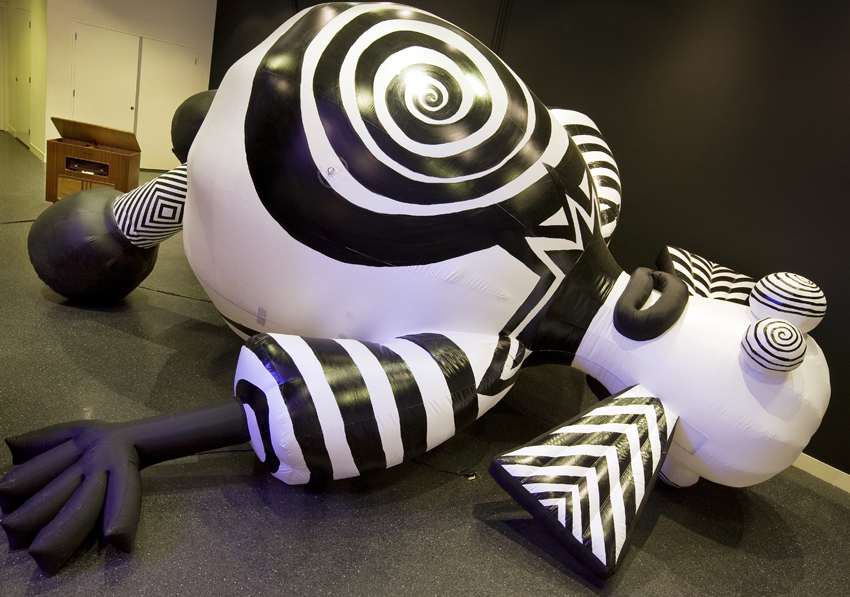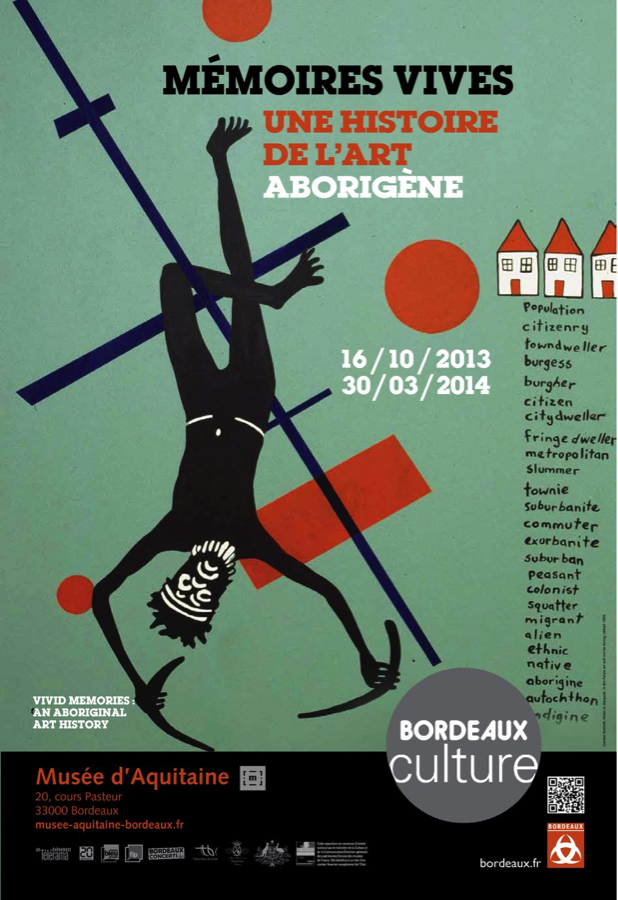
Brook Andrew – Clown I, 2008 – Solo exhibition
Installation view Aboriginal Art Museum, Utrecht, Holland, 2008
VIVID MEMORIES: AN ABORIGINAL ART HISTORY
Curated by Paul Matharan (Curator of Non-European Collections, Musée d’Aquitaine) and Arnaud Morvan (Anthropologist, Laboratoire d’Anthropologie sociale, Paris), the show adopts a broad historical and artistic spectrum by exploring the History of Australian Indigenous Art in its relationship to the ancient and the modern, the old and the new.
The exhibition combines traditional works (including ceremonial objects and artefacts) and contemporary artworks, aiming at understanding the transformations and dynamics of this artistic tradition dating back to more than 40,000 years ago, and which is at the origin of numerous contemporary art movements in Australia.
The scientific committee of the exhibition is composed of Barbara Glowczewski, Ian Mc Lean, Jessica de Largy Heally, Lyndon Ormond-Parker and Arnaud Morvan.
BACKGROUND INFORMATION
European colonisation of Australia in the late 18th century led to the partial dislocation of the 250 Aboriginal cultures present on the continent. However, ritual art, at the heart of religious and social life, has survived in many regions and constitutes the basis for new art forms that have emerged as creative responses to the European invasion. Ground painting, body painting, rock art and ritual performances have thus been transposed to new mobile and permanent media: bark, canvas, photography, video and installations revealing a profound capacity for both formal and conceptual innovation. In other regions, Indigenous artists build on international art history to reinterpret their own cultural heritage. While the majority of traditional practices show a spiritual relation to a sacred geography, the current works also serve to define the place of contemporary artists in a globalised context.
The exhibition investigates the central issue of authenticity which affects most post-contact artworks and aims to demonstrate that tradition and modernity have always been simultaneously active in Australian artistic expression. Many Indigenous artists, with various intercultural influences, are today redefining their material culture in creative ways, conferring upon it a multiplicity of meanings. The exhibition intends to reveal this movement as the renaissance of an ancient culture by linking contemporary works to their traditional sources.
EXHIBITION OVERVIEW
In a 700m2 museum space, the exhibition will present a selection of around 150 works by 60 Indigenous and non-Indigenous artists, including cultural objects, artefacts, bark paintings, acrylic paintings on canvas, photographs, video works and installations.
The exhibition is divided into two major sections devoted respectively to the historical and formal aspects of Aboriginal art, each section being divided into ancient and modern works:
– a first section entitled “Histories” and examining Aboriginal artistic productions before, and then after the colonial contact;
– and a second section dedicated to the “Forms” of Aboriginal Art and their transformations, exploring in turn the visual correspondence between ancient sources and contemporary creations, and phenomena of entanglements, intercultural junctures and cross-fertilization in contemporary Aboriginal Art.
The museum has also invited artist Brook Andrew to create two site-specific installations.
THE ARTISTS
William Barak, Tommy Mc Rea, Albert Namatjira, David Mowarljarlai, Uta Uta Jangala, Yala Yala Gibbs Tjungurrayi, Mick Namarari Tjapaltjarri, Shorty Lungkarda Tjungurrayi, Timmy Payungka Tjapangati, Turkey Tolson Tjupurrula, Coiley Campbell, Cliff Reid, Reko Rennie, Archie Moore, James Iyuna, Tom Djawa, Dawidi, John Mawurndjul, Kay Lindjuwanga, Rover Thomas, Paddy Bedford, Boxer Milner, Ray James Tjangala, Nora Wompi, Eubena Nampitjin, Gordon Bennett, Zhou Xiaoping, Imants Tillers, Karel Kupka, Sydney Nolan, Esther Gilès Nampitjinpa, Nyurapayia Nampitjinpa, Shorty Jangala Robertson, George ward Tjungurrayi, Michael Nelson Jakamarra, Curtis Taylor, Lily Hibberd, Sally Gabori, Pierre Alechinsky, Mike Kelley, Danie Mellor, Paji Honeychild YanKarr, Johnny Bulunbulun, Gary Jones, Tim Johnson, Christian Thompson, Lydia Balbal, Brook Andrew.
The art works come from the following institutions: Quai Branly Museum in Paris, Musée d’art et d’histoire of Rochefort, Aboriginal Art Museum in Utrecht, Museum Victoria in Melbourne, University of Groningen, Musée La Grange in Môtiers, Museum Wereld in Rotterdam, as well as from private collections such as Thomas Vroom, Sordello – Missana, and Brocard – Estrangin.
RESOURCES
A bilingual catalogue of some 200 pages, including a dozen international scientific contributions, will be produced for the occasion, enabling further illustration and exploration of the exhibition’s theme.
To go into more details about the exhibition:
– Read the article by Bertrand Estrangin “Vernissage de l’exposition Mémoires Vives : une histoire de l’art Aborigène, au Musée d’Aquitaine de Bordeaux” (in French).
– Read IDAIA’s October Chronique Curatoriale presenting the latest developments for Australian Indigenous Art on the international art scene, including this exhibition.

Poster of exhibition Vivid Memories: An Aboriginal Art History – Image courtesy Musée d’Aquitaine, Bordeaux
SOURCE : Musée d’Aquitaine, Bordeaux